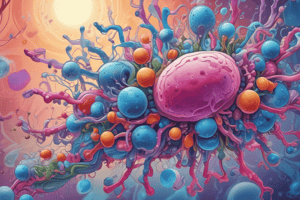Podcast
Questions and Answers
What are pili?
What are pili?
- Gooey outer layer covering the outside of bacteria
- Small circular double stranded bits of DNA
- Long tail-like appendage used to move the bacteria
- Short projections on the outside of a bacteria cell used to adhere to other bacterial cells (correct)
What is the function of flagella?
What is the function of flagella?
To move the bacteria
What does DNA (nucleoid) carry?
What does DNA (nucleoid) carry?
Genetic material
What is the cell membrane?
What is the cell membrane?
What is a capsule in bacteria?
What is a capsule in bacteria?
What are plasmids?
What are plasmids?
The cell wall is useful for the protection of the cell.
The cell wall is useful for the protection of the cell.
What is cytoplasm?
What is cytoplasm?
Flashcards
What are pili?
What are pili?
Short projections on the outside of a bacteria cell used to adhere to other bacterial cells
Function of flagella?
Function of flagella?
To move the bacteria
What does DNA (nucleoid) carry?
What does DNA (nucleoid) carry?
Genetic material
What is the cell membrane?
What is the cell membrane?
Signup and view all the flashcards
What is a capsule?
What is a capsule?
Signup and view all the flashcards
What are plasmids?
What are plasmids?
Signup and view all the flashcards
What is cytoplasm?
What is cytoplasm?
Signup and view all the flashcards
Study Notes
Bacteria Structure Key Components
- Pili: Short projections on the bacterial surface, crucial for adherence to other bacterial cells and surfaces.
- Flagella: Long, tail-like structures that enable motility by propelling the bacteria through liquid environments.
- DNA (Nucleoid): Contains deoxyribonucleic acid, serving as the genetic blueprint that determines cell structure and function.
- Cell Membrane: A semi-permeable barrier that separates the cell's interior (cytoplasm) from the external environment (cell wall).
- Capsule: A gelatinous outer layer, also known as the "slime layer," that provides protection and enhances adherence to surfaces.
- Plasmids: Small, circular DNA fragments that often carry genes for traits such as antibiotic resistance, found predominantly in bacteria and some eukaryotes.
- Cell Wall: A rigid structure surrounding the cell membrane, offering additional protection and structural support to the bacterial cell.
- Cytoplasm: The gel-like substance filling the interior of a cell, comprising cytosol and organelles, each performing vital functions for cellular processes.
Studying That Suits You
Use AI to generate personalized quizzes and flashcards to suit your learning preferences.




